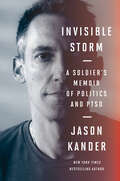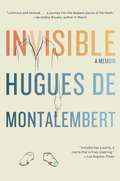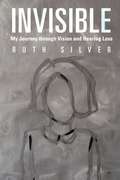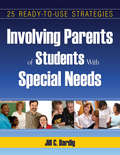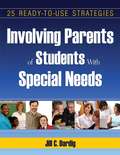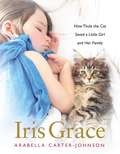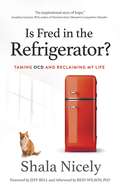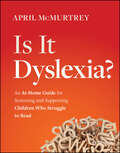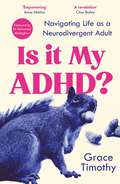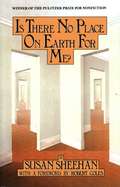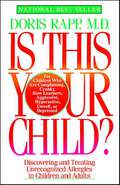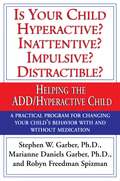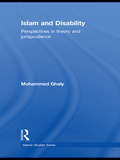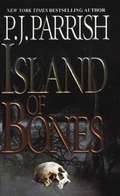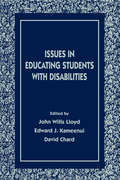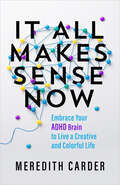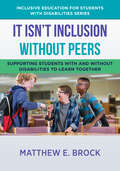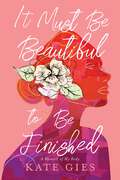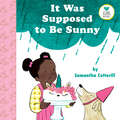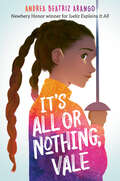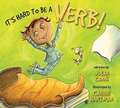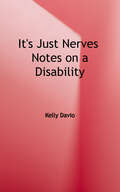- Table View
- List View
Invisible Storm: A Soldier's Memoir of Politics and PTSD
by Jason KanderFrom political wunderkind and former army intelligence officer Jason Kander comes a haunting, powerful memoir about impossible choices—and how sometimes walking away from the chance of a lifetime can be the greatest decision of all. <p><p>In 2017, President Obama, in his final Oval Office interview, was asked who gave him hope for the future of the country, and Jason Kander was the first name he mentioned. Suddenly, Jason was a national figure. As observers assumed he was preparing a run for the presidency, Jason announced a bid for mayor of Kansas City instead and was headed for a landslide victory. But after eleven years battling PTSD from his service in Afghanistan, Jason was seized by depression and suicidal thoughts. He dropped out of the mayor’s race and out of public life. And finally, he sought help. <p><p>In this brutally honest second memoir, following his New York Times best-selling debut Outside the Wire, Jason Kander has written the book he himself needed in the most painful moments of his PTSD. In candid, in-the-moment detail, we see him struggle with undiagnosed illness during a presidential bid; witness his family buoy him through challenging treatment; and, giving hope to so many of us, see him heal. <p> <b>New York Times Bestseller</b>
Invisible: A Memoir
by Hugues De MontalembertThe impressionistic memoir of an artist who was blinded in a sudden act of violence, leading to a profound meditation on what it means to see and be seen. "You live in a city like New York. You read the papers. You look at the television. But you never think it will happen to you. It happened to me one evening. " One summer night in 1978, Hugues de Montalembert returned home to his New York City apartment to find two men robbing him. In a violent struggle, one of the assailants threw paint thinner in Hugues' face. Within a few hours, he was completely blind. Eloquent and provocative, Invisible moves beyond the horrific events of that night to what happened to Hugues after he lost his sight: his rehabilitation, his solo travels around the world, and the remarkable way he learned to "see" even without the use of his eyes. Without a trace of self-pity, Hugues describes his transition from an up-and-coming painter to a blind man who had to learn to walk with a cane. His status changed in the eyes of other people as their reactions ranged from avoidance to making him their confidant. Hugues traveled to faraway places and learned to trust strangers and find himself at home in any situation. Part philosophy, part autobiography, part inspiration, Invisible will change the way readers understand reality and their place in the world.
Invisible: My Journey through Vision and Hearing Loss (2nd Edition)
by Ruth SilverRuth Silver's young life was challenged with vision and hearing loss. Inspired by her own experiences and challenges, she founded the Center for Deaf-Blind Persons in Milwaukee, a nonprofit agency dedicated to helping others living with the double disability of deaf-blindness. Ruth's story demonstrates how a resilient spirit can propel a profoundly disabled person forward toward a happy, productive life.
Involving Parents of Students With Special Needs: 25 Ready-to-Use Strategies
by Jill C. DardigBridge the communication gap with parents of children with special needs! The author provides 25 ready-to-use techniques for involving parents in the education of their children. General and special education teachers in Grades PreK–12 can use these strategies to reach the parents of students with a wide range of learning needs. This teacher-friendly resource provides sample materials and tips for: Using letters, telephone, email, newsletters, and progress reports to communicate with parents Conducting parent conferences and in-person meetings Connecting parents with resources Helping parents teach their children at home Dealing with home/school conflicts Preparing a parent involvement action plan
Involving Parents of Students with Special needs: 25 Ready-to-Use Strategies
by Jill C. DardigThis book helps readers with real-world situations. It is easy and user-friendly, this book provides strategies and tools to aid in communicating with parents.
Iris Grace: How Thula the Cat Saved a Little Girl and Her Family
by Arabella Carter-JohnsonIris Grace is a beautiful little girl who, from a very young age, barely communicated, avoided social interaction with other people, and rarely smiled. From both before her diagnosis of autism and after, she seemed trapped in her own world, unable to connect with those around her. One day, her mother brought home a Maine Coon kitten for Iris, even though cats aren’t typically thought of as therapy pets. Thula, named after one of Iris’s favorite African lullabies and meaning ?peace” in Zulu, immediately bonded with Iris. Thula knew right away how to assuage Iris when she became overstimulated; when to intervene when Iris became overwhelmed; and how to provide distraction when Iris started heading toward a meltdown. Whether exploring, playing, sleeping, or taking a bath with Iris or accompanying the family on a bike ride, Thula became so much more than a therapy cat. With Thula’s safe companionship, Iris began to talk and interact with her family. This heartwarming story is illustrated with sixty of Iris’s gorgeous impressionistic paintings, works of art that have allowed her to express herself since the age of three. A gifted artist, Iris sees the natural world in a profoundly vivid and visceral way. With Thula by her side, she’ll sit and paint for hours, and the results are stunning. Inspiring and touching, Iris Grace follows the struggles and triumphs of a family?and a miracle cat?as they learn to connect with an amazing child.
Is Fred in the Refrigerator?: Taming OCD and Reclaiming My Life
by Shala Nicely<p>A gripping memoir that gives voice to the invisible, life-destroying power of obsessive-compulsive disorder, and how one woman stood up to fear, embraced the unknown, and reclaimed her life. <p>Even at nine years old, Shala Nicely knew there was nothing normal about the horrifying thoughts that tormented her at bedtime, or the nightly rituals she summoned to beat them back. More importantly, she knew to obey her mind's Rule #1: keep its secret, or risk losing everything and everyone she loved. <p>It would be almost two decades before she learned the name of the menacing monster holding her hostage: obsessive-compulsive disorder (OCD). It would take years longer to piece together the keys to recovery that would change her life forever, beginning with the day she broke her monster's silence. <p>Writing with wry wit, unflinching candor, and resounding insight, Shala takes readers on a riveting journey into the dark and dimly understood inner workings of OCD and its frequent co-conspirator, body dysmorphic disorder (BDD). Thwarted repeatedly as she struggles to escape the clutches of these formidable foes, she finally stumbles upon an unexpected path to freedom. As she journeys into the heart of fear to reclaim her life, she weaves a self-compassionate roadmap to recovery: to living in an uncertain world and being happy anyway. <p>With an Afterword by Reid Wilson, PhD offering powerful guidance for applying Shala's strategies in daily life, Is Fred in the Refrigerator? will leave legions of those affected by mental illness feeling seen, understood, and empowered. </p>
Is It Dyslexia?: An At-Home Guide for Screening and Supporting Children Who Struggle to Read
by April McMurtreyHands-on resources for screening readers of all ages for dyslexia In Is It Dyslexia?, certified dyslexia assessment specialist April McMurtrey delivers an accessible, hands-on framework for screening readers of various ages for dyslexia.. The book offers comprehensive, clear, and step-by-step processes you can apply immediately to confidently and accurately screen readersfor dyslexia. The author shares the tools and strategies used by professional screeners, as well as first, next, and final steps you can take as you move forward with your screening results. The book includes: Explanations of what dyslexia is, as well as an overview of common talents and strengths often found in readers with dyslexia A collection of recommended accommodations for students with dyslexia in the home and school and effective literacy instruction for students with dyslexia A comprehensive dyslexia questionnaire, eleven different screening tests, and step-by-step instructions for administering themIdeal for tutors, homeschool teachers, parents, instructional coaches, counselors, and speech-language therapists, Is It Dyslexia? comes complete with reproducibles and links to video tutorials required for screening students of various ages.
Is It Me or My Meds: Living with Antidepressants
by David A. KarpThis book gives voice to those who are depressed and to those who use medications so that they are not depressed. Full of useful information.
Is It My ADHD?: Navigating life as a neurodivergent adult
by Grace TimothyDarkly funny, relatable and unflinchingly honest, Is it My ADHD? gives irreverent and intersectional insight into what life is like for women living with Attention Deficit Hyperactivity Disorder. Much like the 3-4% of the British population with ADHD, Grace Timothy always felt on the outskirts of 'normal'. After a lifetime of mental and physical symptoms that didn't quite add up, she was finally diagnosed in 2021. At the time, information was scant. Now, neurodivergence is the hot topic on everyone's lips. With this increased awareness, we've encountered a new challenge: how can we circumnavigate the misinformation and better understand our own brains? Writer and podcaster Grace Timothy speaks to those living with ADHD to explore traits specific to women, grounding each chapter in clinical research and expert commentary. Offering comfort and real, triedand-tested tips along the way, this book is for anyone who's ever wondered, is it my ADHD?
Is There No Place on Earth for Me?
by Susan SheehanSylvia Frumkin a highly intelligent young girl became a schizophrenic in her late teens and spent most of the next seventeen years in and out of mental institutions. Susan Sheehan followed Sylvia for almost a year, talking with and observing her.
Is This Your Child?: Discovering and Treating Unrecognized Allergies in Children and Adults
by Doris RappIS THIS YOUR CHILD?These are the major symptoms of potentially unrecognized allergies. Does your child suffer from any of the following?• Allergic Nose Rub • Eye Circles • Red Ears • Red Cheeks • Eye Wrinkles • Aggression • Lack of Alertness • Mottled Tongue • In this breakthrough book, Dr. Doris Rapp offers a simple yet effective approach to handling "problem" children. Is This Your Child? shows parents how to identify the common foods, chemicals, or common allergic substances that could be the culprits that cause some children or adults to feel unwell or act inappropriately. If your child is always sick, hyperactive, a slow learner, or cranky, the first question you should ask is not "What drug should be prescribed?" or "What have I done wrong as a parent?" Instead, find out the cause. Dr. Rapp gives sensible suggestions about how these reactions to foods and environmental factors can be recognized, prevented, and treated. With this information, many affected children should feel, act, behave, and learn better. If you can detect unsuspected environmental illness in your child--or yourself--you can change your lives so you're more content, happy, and free of illness.
Is Your Child Hyperactive? Inattentive? Impulsive? Distractible?: Helping the ADD/Hyperactive Child
by Stephen W. Garber Marianne Daniels Garber Robyn Freedman SpizmanEvan, five years old, hardly stands, much less sits, still for more than a few moments. Jessie is eight -- she's adorable...she never finishes anything on time...she's a dreamer. Cal is fifteen -- he is so impulsive that his parents worry he'll try drugs on a whim.What do these kids have in common? Do they remind you of your own children?The most talked-about childhood syndrome of the eighties and nineties is ADHD (attention deficit hyperactivity disorder). This developmental disorder disrupts a child's life and often results in low self-esteem, poor grades and even social and emotional problems. These problems usually are not outgrown -- without help. But does your child have ADHD?ADHD is characterized by the following groups of behaviors:Inattention-- making careless mistakes-- difficulty sustaining attention-- problems with listening-- failure to finish schoolwork or chores-- difficulties organizing-- trouble sustaining mental efforts-- losing things-- being easily distracted-- forgetfulness Hyperactivity/Impulsivity-- fidgeting/squirming-- trouble staying seated-- inappropriate running/climbing-- difficulty playing quietly-- being on the go/driven-- talking excessively-- blurting out answers-- difficulty awaiting turn-- often interruptingAll children display many of these behaviors at some point. But-according to the Diagnostic and Statistical Manual of the American Psychiatric Association, Fourth Edition, for a child to be diagnosed with ADHD, six or more of these symptoms of inattention and/or hyperactivity/impulsivity must have persisted for at least six months.Is Your Child Hyperactive? Inattentive? Impulsive? Distractible? offers an invaluable step-by-step program already used by thousands of parents to help you change these behaviors at home. Don't just watch it happen; help your child help himself.From the Trade Paperback edition.
Islam and Disability: Perspectives in Theology and Jurisprudence (Routledge Islamic Studies Series)
by Mohammed GhalyThis book explores the position of Islamic theology and jurisprudence towards people with disabilities. It investigates how early and modern Muslim scholars tried to reconcile their existence with the concept of a merciful God, and also looks at how people with disabilities might live a dignified and productive life within an Islamic context. In his analysis of Islamic Theology, Ghaly pays attention to how theologians, philosophers and Sufis reflected on the purposes behind the existence of this phenomenon, and how to reconcile the existence of disability with specific divine attributes and an All-Merciful God. Simultaneously exploring the perspective of Muslim jurists, the book focuses on how people with disabilities can lead a dignified life in the financial and non-financial sense, in an extensive analysis of topics such as the human dignity of people with disabilities and the role of Greek physiognomy, their employability, medical treatment, social life with main focus on marriage-related issues, financial life and means of living. Investigating the topic of disability from early and modern Islamic perspectives, the author provides an analysis of Muslim discussions on various bioethical questions. As such, this book will be of great relevance to current heated debates on human rights of people with disabilities, as well as providing a valuable resource for courses on Multicultural bioethics, Islamic theology, Islamic law and medical anthropology.
Island of Bones (Louis Kincaid #5)
by P. J. ParrishISLAND OF SECRETS. In the wake of a hurricane, a tiny bleached skull washes up in front of Detective Louis Kincaid's cottage. Days later, the bullet-ridden body of a woman surfaces on a nearby beach. She has no identification...except for a unique ring carved out of bone on her finger... ISLAND OF TERROR. Sensing a connection between the dead woman and the skull he's found, Louis starts investigating. His search for the truth will lead him down a trail of hidden secrets and lies to face utter evil on a lonely island where treachery never dies and the living never escape... ISLAND OF BONES.
Issues in Aging and Vision: A Curriculum for University Programs and In-service Training
by Alberta L. OrrThe demographics and psychosocial aspects of aging and vision loss, community-based services for blind older persons, improving access to vision rehabilitation.
Issues in Educating Students With Disabilities (The LEA Series on Special Education and Disability)
by Edward J. Kameenui David Chard John Wills LloydThe contributors to this volume represent the most prominent researchers and thinkers on issues in educating students with and without disabilities. The book captures the most current thinking, research, and analysis on the full range of issues in educating students with learning disabilities, from its definition to the most recent case law and interpretations of federal law on educating these students in the general education classroom. The contributors' words speak sufficiently, mellifluously, and exactingly about their contributions to the education of all students, in particular those with disabilities. This book of essays was written to pay tribute to Barbara D. Bateman, who -- along with Sam Kirk -- coined the term "learning disabilities." Its content reflects the significance of her contributions to the field of special education.
It All Makes Sense Now: Embrace Your ADHD Brain to Live a Creative and Colorful Life
by Meredith CarderFrom the personal and coaching experience of an ADHDer, actionable tools and techniques to understand your ADHD brain and unlock life's possibilities.Do you often feel that your emotions are intense and difficult to regulate? Does boredom get to you seemingly more than most? Do you struggle with your perception of time?You're not alone. As cultural and medical awareness around ADHD shifts, millions of adults who are diagnosed with ADHD are unclear on the many ways ADHD symptoms present and how it affects the experience of their everyday life.Meredith Carder, an ADHD coach and ADHDer herself, shares real-life stories from her coaching practice and own lived experience along with actionable exercises and strategies to help you: Harness the power of self-compassion and self-awareness to embrace your unique brainBuild your own toolkit of daily habits to prevent boredom and burnoutRate your level of focus and plan your energy accordinglyLearn to appreciate your ADHD brain and empower yourself to live a life rich with interestBy learning more about the way your mind works, you too can rewrite your inner dialogue and fully realize the life you want to live.
It Isn't Inclusion Without Peers: Supporting Students With and Without Disabilities to Learn Together (The Norton Series on Inclusive Education for Students with Disabilities #0)
by Matthew BrockPeer-mediated interventions benefit all students in the classroom. Peer-mediated interventions are a category of practices in which students without disabilities provide academic and social support to classmates with disabilities in inclusive classrooms, cafeterias, and on playgrounds. These support strategies are shown to have positive effects on academic, interpersonal, and social development—not only for students with disabilities, but also for their classmates who serve as peer supports. Students with a variety of disabilities benefit from peer-mediated support interventions, including students with intellectual disabilities, autism spectrum disorder, and multiple disabilities. In this book, Matthew Brock provides educators with a practical guide to the implementation of peer-mediated interventions. General and special education teachers will receive expert guidance on how to decide which combination of interventions is likely to work best for each child, and how to collaborate with paraeducators and each other to implement the selected strategies.
It Must Be Beautiful to Be Finished: A Memoir of My Body
by Kate GiesA raw, beautiful memoir of a girl born missing an ear, a medical system insistent on saving her from herself, and our culture&’s desire to &“fix&” bodies.When Kate Gies was four years old, a plastic surgeon pressed a synthetic ear to the right side of her head and pulled out a mirror. He told her he could make her &“whole&”—could make her &“right&”—and she believed him. From the age of four to thirteen, she underwent fourteen surgeries, including skin and bone grafts, to craft the appearance of an outer ear. Many of the surgeries failed, leaving permanent damage to her body. In short, lyrical vignettes, Kate writes about how her &“disfigured&” body was scrutinized, pathologized, and even weaponized. She describes the physical and psychic trauma of medical intervention and its effects on her sense of self, first as a child needing to be fixed and, later, as a teenager and adult navigating the complex expectations and dangers of being a woman. It Must Be Beautiful to Be Finished is the story of a girl desperately trying to have a body that makes her acceptable and of a woman learning to own a body she has never felt was hers to define. In an age of speaking out about the abuse of marginalized bodies, this memoir takes a hard look at the role of the medical system in body oppression and trauma.
It Was Supposed to Be Sunny (Little Senses)
by Samantha CotterillA perfectly planned birthday party goes awry in this gentle story about adapting to the unexpected, written for kids on the autism spectrum and called &“brilliant&” and &“engaging&” by autism specialist Tony AttwoodLaila feels like her sparkly sunshine birthday celebration is on the brink of ruin when it starts to storm. Then, just as she starts feeling okay with moving her party indoors, an accident with her cake makes her want to call the whole thing off. But with the help of her mom and a little alone time with her service dog, she knows she can handle this. Changes in routine can be hard for any kid, but especially for kids on the autism spectrum. Samantha Cotterill's fourth book in the Little Senses series provides gentle guidance along with adorable illustrations to help every kid navigate schedule changes and overwhelming social situations.
It's $5 Extra for Cerebral Palsy
by Anthony M. Aversano Marie A. LacerraMarie A. Lacerra was born with severe Cerebral Palsy before the days of "accessibility," "normalization," and laws protecting the rights of people with disabilities. However, despite a world which was not ready for her, Marie was blessed with family and friends who were ahead of their time and not afraid to show the world who Marie was. Finally released from the prison of unintelligible speech by modern technology, Marie is now able to tell her stories --stories much like the ones we tell everyday: filled with love and laughter, tears and loss, hope and courage. With the help of a special "word hunting" computer, and a deep desire to communicate, her inspirational stories reveal the power of the human spirit and paint a vivid picture of the prejudice and difficulties a person with Cerebral Palsy must face.
It's All or Nothing, Vale
by Andrea Beatriz ArangoA poignant novel in verse in which, after a life-changing accident, one girl finds her way back to her life&’s passion. From the Newbery Honor-winning author of Iveliz Explains It All.All these months of staring at the wall?All these months of feeling weak?It&’s ending—I&’m going back to fencing.And then it&’ll belike nothing ever happened.No one knows hard work and dedication like Valentina Camacho. And Vale&’s thing is fencing. She&’s the top athlete at her fencing gym. Or she was . . . until the accident.After months away, Vale is finally cleared to fence again, but it&’s much harder than before. Her body doesn&’t move the way it used to, and worst of all is the new number one: Myrka. When she sweeps Vale aside with her perfect form and easy smile, Vale just can&’t accept that. But the harder Vale fights to catch up, the more she realizes her injury isn&’t the only thing holding her back. If she can&’t leave her accident in the past, then what does she have to look forward to?In this moving novel from the Newbery Honor-winning author of Iveliz Explains It All, one girl finds her way back to her life&’s passion and discovers that the sum of a person's achievements doesn&’t amount to the whole of them.
It's Hard To Be A Verb!
by Julia Cook<p>Louis is a verb <p>He has a lot of trouble focusing and he is always doing something, but the problem is usually it's the wrong something. <p>It's hard to be a verb <p>My knees start itching, my toes start twitching, my skin gets jumpy, others get grumpy. <P><P> When it comes to sitting still it's just not my deal. <p>Haven't you heard. . . <p> I am a verb <p>His mom teaches him how to focus by showing him a few hands on ideas that anyone can try. <P>A must have book for all who struggle with paying attention
It's Just Nerves: Notes on a Disability
by Kelly DavioWith equal parts wit and empathy, lived experience and cultural criticism, Kelly Davio's It's Just Nerves: Notes on a Disability explores what it means to live with an illness in our contemporary culture, whether at home or abroad. "When the body attacks itself, the crisis is not just of bones and blood, but of beauty and boundaries. 'Strange men have had their hands on me for days, ' Kelly Davio observes during a plasma treatment. Her skillful portrait of myasthenia gravis does not exist in a vacuum. It's Just Nerves is in keen dialogue with the world around us--critiquing modern health care, pub seating etiquette, alarming election outcomes, smarmy meditation culture, and caricatures of illness in ads and on screen. 'Oxygen is delicious, ' Davio reminds us, before the fire breaks out. A brisk, funny, and at times startlingly poetic memoir." --Sandra Beasley, author of Don't Kill the Birthday Girl: Tales from an Allergic Life. "Kelly Davio's It's Just Nerves feels like the book I've been waiting for all my life. If you want to know what it feels like to be a person with a disability in the 21st century, read this book. From mindfulness to yoga pants, Davio skewers ableist fabrications and brings us to a vital, ebullient, and sometimes terrifying reckoning with our real and shared human experience. She is a very funny writer and also a fearless one. Once I started reading these essays, I couldn't put them down; they resounded through me like poetry or truth." --Sheila Black, author of House of Bone and Love/Iraq. "Kelly Davio's got so much incredible stuff brewing together on every page of these nimble, shapeshifting essays: meditations on the politics of illness, the body in crisis, the spirit in bloom, David Bowie--all of it filtered, carefully, through the lithe sensibility of a poet. The results are equal parts witty and wise, heartrending and rapturous. Man, I loved this book." --Mike Scalise, author of The Brand New Catastrophe.
